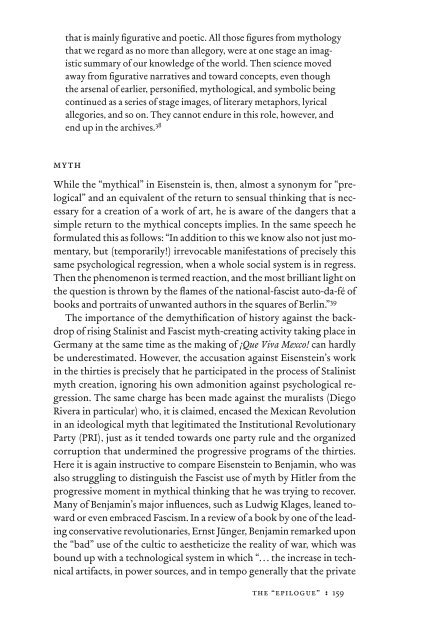In Excess: Sergei Eisentein's Mexico - Cineclub
In Excess: Sergei Eisentein's Mexico - Cineclub
In Excess: Sergei Eisentein's Mexico - Cineclub
You also want an ePaper? Increase the reach of your titles
YUMPU automatically turns print PDFs into web optimized ePapers that Google loves.
that is mainly fi gurative and poetic. All those fi gures from mythology<br />
that we regard as no more than allegory, were at one stage an imagistic<br />
summary of our knowledge of the world. Then science moved<br />
away from fi gurative narratives and toward concepts, even though<br />
the arsenal of earlier, personifi ed, mythological, and symbolic being<br />
continued as a series of stage images, of literary metaphors, lyrical<br />
allegories, and so on. They cannot endure in this role, however, and<br />
end up in the archives. 38<br />
myth<br />
While the “mythical” in Eisenstein is, then, almost a synonym for “prelogical”<br />
and an equivalent of the return to sensual thinking that is necessary<br />
for a creation of a work of art, he is aware of the dangers that a<br />
simple return to the mythical concepts implies. <strong>In</strong> the same speech he<br />
formulated this as follows: “<strong>In</strong> addition to this we know also not just momentary,<br />
but (temporarily!) irrevocable manifestations of precisely this<br />
same psychological regression, when a whole social system is in regress.<br />
Then the phenomenon is termed reaction, and the most brilliant light on<br />
the question is thrown by the fl ames of the national-fascist auto-da-fé of<br />
books and portraits of unwanted authors in the squares of Berlin.” 39<br />
The importance of the demythifi cation of history against the backdrop<br />
of rising Stalinist and Fascist myth-creating activity taking place in<br />
Germany at the same time as the making of ¡Que Viva Mexco! can hardly<br />
be underestimated. However, the accusation against Eisenstein’s work<br />
in the thirties is precisely that he participated in the process of Stalinist<br />
myth creation, ignoring his own admonition against psychological regression.<br />
The same charge has been made against the muralists (Diego<br />
Rivera in particular) who, it is claimed, encased the Mexican Revolution<br />
in an ideological myth that legitimated the <strong>In</strong>stitutional Revolutionary<br />
Party (PRI), just as it tended towards one party rule and the organized<br />
corruption that undermined the progressive programs of the thirties.<br />
Here it is again instructive to compare Eisenstein to Benjamin, who was<br />
also struggling to distinguish the Fascist use of myth by Hitler from the<br />
progressive moment in mythical thinking that he was trying to recover.<br />
Many of Benjamin’s major infl uences, such as Ludwig Klages, leaned toward<br />
or even embraced Fascism. <strong>In</strong> a review of a book by one of the leading<br />
conservative revolutionaries, Ernst Jünger, Benjamin remarked upon<br />
the “bad” use of the cultic to aestheticize the reality of war, which was<br />
bound up with a technological system in which “. . . the increase in technical<br />
artifacts, in power sources, and in tempo generally that the private<br />
the “epilogue” : 159


